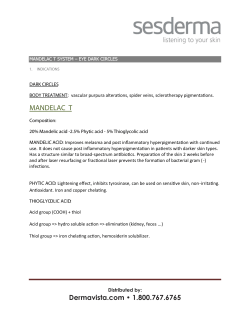
SAMPLE PROCEDURE
SAMPLE PROCEDURE This “Sample Procedure” is not intended as a substitute for your facility’s Procedure Manual or reagent labeling, but rather as a model for your use in customizing for your laboratory’s needs. Space has been provided within the document to allow you to update this template with information specific to your facility. It is suggested that a current version of the manufacturer’s directional insert be maintained as a supplement. 1 1051-5, 07/11 PROCEDURE Title: Sekisui Diagnostics OSOM® BVBLUE® Test Procedure #: Institution: __________________________________________________________ Prepared by: ___________________________ Date: __________________________ Title: __________________________________________________________ Accepted by: ___________________________ Date adopted: __________________ Title: __________________________________________________________ Reviewed by:___________________________ Date: __________________________ ___________________________ __________________________ ___________________________ __________________________ ___________________________ __________________________ ___________________________ __________________________ ___________________________ __________________________ ___________________________ __________________________ ___________________________ __________________________ ___________________________ __________________________ ___________________________ __________________________ ___________________________ __________________________ ___________________________ __________________________ ___________________________ __________________________ Discontinued by:_________________________ Date:__________________________ 2 1051-5, 07/11 I. TEST NAME OSOM® BVBLUE® Test This is a CLIA Waived Test For facilities in the US: A CLIA Certificate of Waiver is needed to perform testing in waived settings. Read all instructions carefully before use. If a laboratory modifies the following test instructions including Quality Control, the test will be considered High Complexity and no longer considered Waived. II. INTENDED USE The OSOM BVBLUE Test is an enzyme activity test for use in the detection of vaginal fluid specimens for sialidase activity, an enzyme produced by bacterial pathogens such as Gardnerella vaginalis, Bacteroides spp., Prevotella spp., and Mobiluncus spp. The OSOM BVBLUE Test is indicated for use in women suspected of having Bacterial Vaginosis (BV) infection, e.g., women with vaginal discharge typical of BV and/or women with previous history of BV, as an aid in the diagnosis of BV infection. Test results should be considered in conjunction with other clinical and patient information (see Limitations of the Procedure). For In Vitro Diagnostic Use Only. The OSOM BVBLUE Test is indicated for professional use only and may be used at the point of care and/or in physician's offices. It is not intended for home use. III. SUMMARY AND EXPLANATION OF TEST Vaginitis is one of the most common reasons that women visit obstetricians or gynecologists1–3. BV is the most common form of infectious vaginitis. The causative agents of the infection are bacterial pathogens such as Gardnerella vaginalis, Bacteroides spp., Prevotella spp., and Mobiluncus spp. Complications associated with BV include salpingitis, endometritis, post-hysterectomy infections recurrent UTI’s and an increased risk of PID and HIV 5-7. BV represents a serious danger in women due to its significant association with placental infection, premature rupture of membranes, and preterm birth 8-10. Studies have shown elevated sialidase activity in women with BV and an increased risk for preterm birth and low birth weight infants in patients exhibiting elevated sialidase activity 4, 11-15. The OSOM BVBLUE Test is designed to provide a clear, simple indication of elevated sialidase activity in patient vaginal fluid samples. The generation of a blue or green color indicates a positive test result; a yellow color indicates a negative test result. IV. PRINCIPLES OF TEST The OSOM BVBLUE Test contains a chromogenic substrate of bacterial sialidase. In the test procedure, a vaginal fluid sample is placed in the BV Test Vessel. The sample then reacts with the chromogenic substrate. A Developer Solution is added after the reaction. If the sample has a high level of sialidase, a blue or green color will be seen in the BV Test Vessel or on the head of the swab. If the sample has no sialidase, or has very low levels, a yellow color will be seen in the BV Test Vessel 3 1051-5, 07/11 V. REAGENTS / MATERIALS IBX-4041 component (0.25 mg/test) potassium acetate (24.5 mg/test) sodium hydroxide (1.0 mg/test) Materials Provided: 25 Test Vessels each containing 0.25 mg IBX-4041 component in 0.5 mL of an aqueous potassium acetate buffer solution (49 mg/mL; 0.5 M; pH 5.5–6.0). 1 Developer Solution Bottle containing 10.0 mL of an aqueous sodium hydroxide solution (40.0 mg/mL; 1.0 M; pH>11.0). Sterile Swabs 1 Directional Insert Materials Required But Not Provided: OSOM BVBLUE Control Kit Timer VI. WARNINGS AND PRECAUTIONS For In Vitro Diagnostic Use Only. Do not use after the expiration date printed on the kit. Do not store kit at temperatures above 8° C (46° F). Do not store the kit in strong light. Follow your laboratory safety guidelines in the collection, handling, storage and disposal of patient specimens and all items exposed to patient specimens. Used tests should never be re-used. This product is intended for vaginal fluid use only. For this facility, sample swabs and used test tubes are disposed: . . VII. PATIENT PREPARATION, SPECIMEN COLLECTION & STORAGE This facility’s procedure for patient preparation is: . . This facility’s procedure for sample labeling is: . . Specimen Collection and Handling: Using a swab from the kit, collect specimens with a swab from the lower one-third of the vaginal wall. Collecting specimens from the cervix should be avoided because (a) it might increase risk to OB patients, and (b) cervical sialidase activity is usually higher than vaginal sialidase activity. Do not use specimens from patients who have (a) used a vaginal cream or ointment product, (b) douched, or (c) used spermicides, vaginal lubricants or feminine sprays within 72 hours of testing. 4 1051-5, 07/11 Test the patient specimen as soon as possible after collection. If you do not perform the OSOM BVBLUE test immediately, store the swabs either at room temperature for up to 48 hours or refrigerated for up to 7 days. To transport patient specimens, place each swab in a clean, dry container such as a plastic or glass tube. Do not use any transport media. If you do not collect enough sample or collect from a patient undergoing antimicrobial therapy the test may give a false negative result. This facility’s procedure for transporting specimens is: . . This facility’s procedure for rejected specimens is: . . VIII. STORAGE AND STABILITY Store the kit at controlled temperature, 2°-8°C (36°-46°F), out of direct sunlight. Store vessels inside the box. Kit contents are stable until the expiration date printed on the outer box. NOTE: Allow the kit to come to room temperature before running the test. At this facility, kits are stored: IX. . INDICATIONS OF INSTABILITY Signs of possible product instability include: A blue color in a BV Test Vessel when one drop of Developer Solution is added to the BV Test Vessel in the absence of a patient specimen. Positive control does not give expected results. Negative control does not give expected results. X. QUALITY CONTROL & ASSURANCE 1. Internal Quality Controls The OSOM BVBLUE Test contains two types of internal quality control with each test run. For daily quality control, the manufacturer recommends documenting these controls on each day of testing: Type 1 Control: Before adding a patient specimen, inspect the BV Test Vessel. It should contain a colorless liquid without precipitates (sediment). If the testing vessel contains a precipitate, the test is invalid. Do not use the BV Test Vessel. Type 2 Control: The OSOM BVBLUE Test has a two-color result format: blue/green is positive, yellow is negative. After running the test according to the instructions for use, the appearance of either a uniform yellow, blue, or green color in the testing vessel or a blue or green color on the swab assures proper mixing of the reagent and sample has occurred. If the test fails to provide either a blue, green, or a yellow color result the test is invalid. Do not report patient results if either the Type 1 Control or the Type 2 Control does not produce expected results. 5 1051-5, 07/11 2. External Quality Controls External Controls (available from Sekisui Diagnostics), are used to test that the reagents are working properly. Also use the Controls to test that you are able to correctly perform the test procedure. A Control Kit that contains a positive control and a negative control is available from Sekisui Diagnostics and may be purchased separately, Catalog No. 184. Refer to the Control Kit Directional Insert for instructions on how to interpret the results of the controls. If QC testing fails: Check expiration dates of the test kit and controls Ensure the instructions for testing were followed Repeat the test If the controls still do not perform as expected contact Sekisui Diagnostics Technical Service at 1800-332-1042. 2a. For CLIA Waived Labs You should follow the guidelines below for QC testing. The manufacturer recommends that external controls be run with each new lot, each new shipment and with each new untrained operator. 2b. For CLIA Non-Waived Labs Quality Control requirements should be established in accordance with local, state and federal regulations or accreditation requirements. Minimally, the manufacturer recommends that external controls be run with each new lot, each new shipment and with each new untrained operator. QC Testing Frequency and Documentation For this facility, External QC is run: . . Results of External QC and action(s) taken when control results are unacceptable are documented: . . XI. LIMITATIONS Do not use samples from the cervix. Patients may have mixed infections. The OSOM BVBLUE Test shows that sialidase enzyme is active in the sample. The OSOM BVBLUE Test does not show if other organisms such as yeast and parasitic organisms are present in the sample. Test results should be considered in conjunction with other clinical and patient information. Test operators must follow all instructions to a) collect the sample, b) store the sample, and c)use the test procedure properly. If the instructions are not followed, the OSOM BVBLUE test may not give correct results. 6 1051-5, 07/11 XII. EXPECTED VALUES The OSOM BVBLUE Test can show sialidase activity in vaginal fluid at levels of ≥7.8U. There are two possible results; positive or negative. If the test fails to provide a blue, green, or yellow color result, the test is invalid. XIII. INSTRUCTIONS FOR USE Allow the kit to come to room temperature before running the test. STEP 1 Remove one BV Test Vessel and the Developer Solution Bottle from the kit prior to use. Remove the cap from the BV Test Vessel. STEP 2 Collect a vaginal fluid sample with a swab. Contact the swab with the lower one-third of the vaginal wall. Collect as much fluid as possible. NOTE: Do not use samples from patients who have used vaginal cream products within 72 hours before testing. Do not touch or collect fluid near the cervix. STEP 3 Put the swab into the BV Test Vessel. Gently swirl the mixture. STEP 4 Let the BV Test Vessel containing the swab stand for 10 minutes between 17° and 37°C, (62.6°98.6°F). STEP 5 Add one drop of Developer Solution to the BV Test Vessel containing the swab. Gently swirl the mixture. Read the results immediately. CAUTION: The Developer Solution is a dilute alkaline solution. This may cause skin and eye irritation. If the solution comes in contact with the skin or eyes, flush with large volumes of water. XIV. INTERPRETATION OF TEST RESULTS There are two possible results: (a) positive result or (b) negative result. a) Positive Result: A blue or green color in the BV Test Vessel or on the head of the swab. b) Negative Result: A yellow color in the BV Test Vessel. NOTE: You may need to remove the swab to read the test results. A Positive Result shows a high level of sialidase activity. A Negative Result shows a normal level of sialidase activity. In the event this test becomes inoperable, this facility’s course of action for patient samples is: . 7 1051-5, 07/11 XV. RESULT REPORTING This facility’s procedure for patient result reporting is: . . . . XVI. CROSS REACTIVITY In all clinical studies, no evidence of interference was observed for menses (n=118); blood (n=620); semen (n=620); birth control methods (n=36) including birth control pills, Depo-Provera, Norplant, IUDs, condoms, or tubal ligation; or microorganisms (n=118) including Staphylococcus, Streptococcus, E. coli, Candida albicans, Lactobacillus, among others. XVII. PERFORMANCE CHARACTERSITICS & POL STUDIES Refer to directional insert – OSOM BVBLUE Test XVIII. REFERENCES Refer to directional insert – OSOM BVBLUE Test XIX. ASSISTANCE For assistance contact Sekisui Diagnostics Technical Assistance at (800) 332-1042. OSOM® is a registered U.S. trademark of Sekisui Diagnostics, LLC. BVBLUE® is a registered trademark of Gryphus Diagnostics, LLC. 8 1051-5, 07/11
© Copyright 2025












